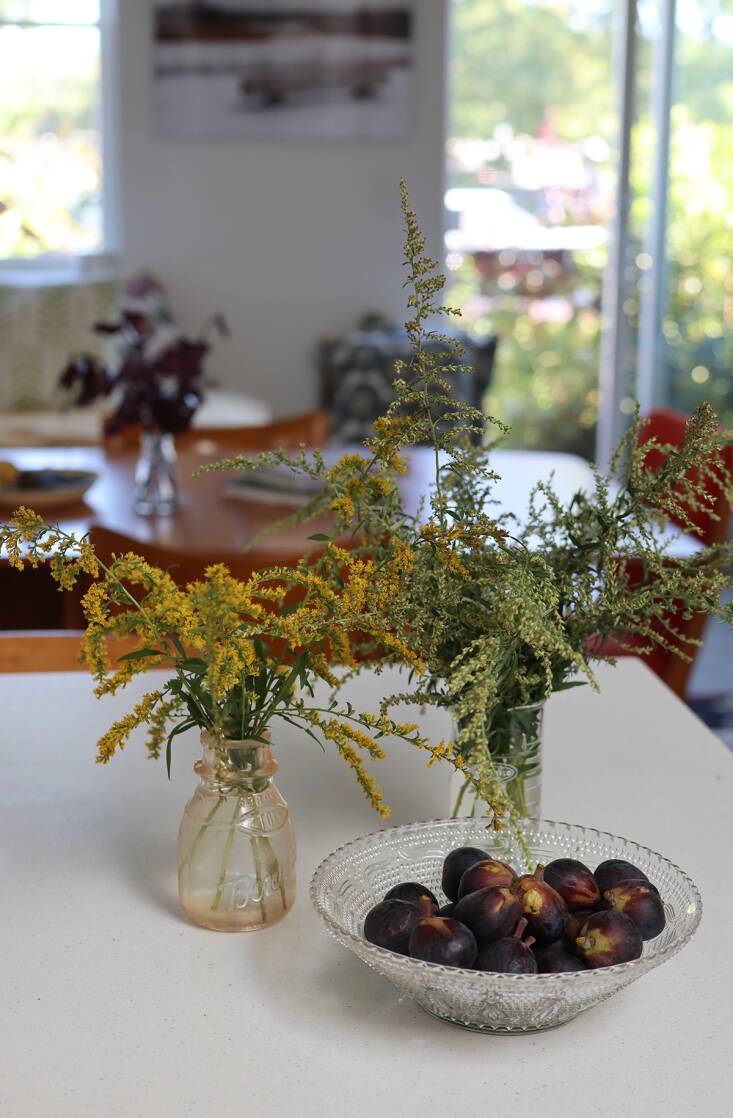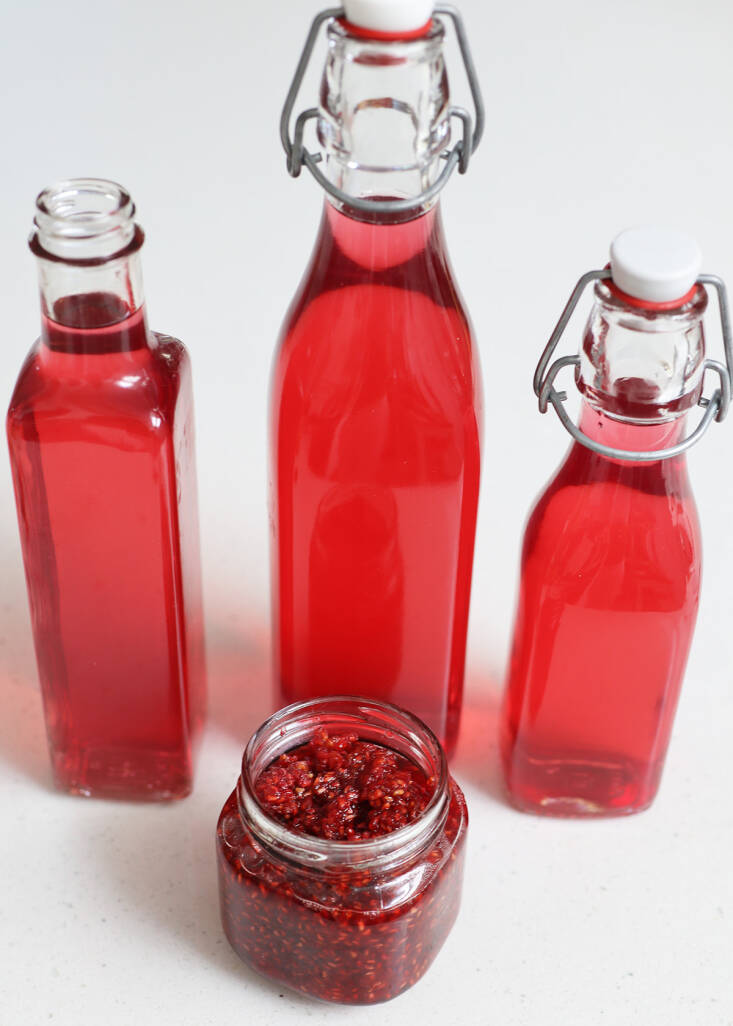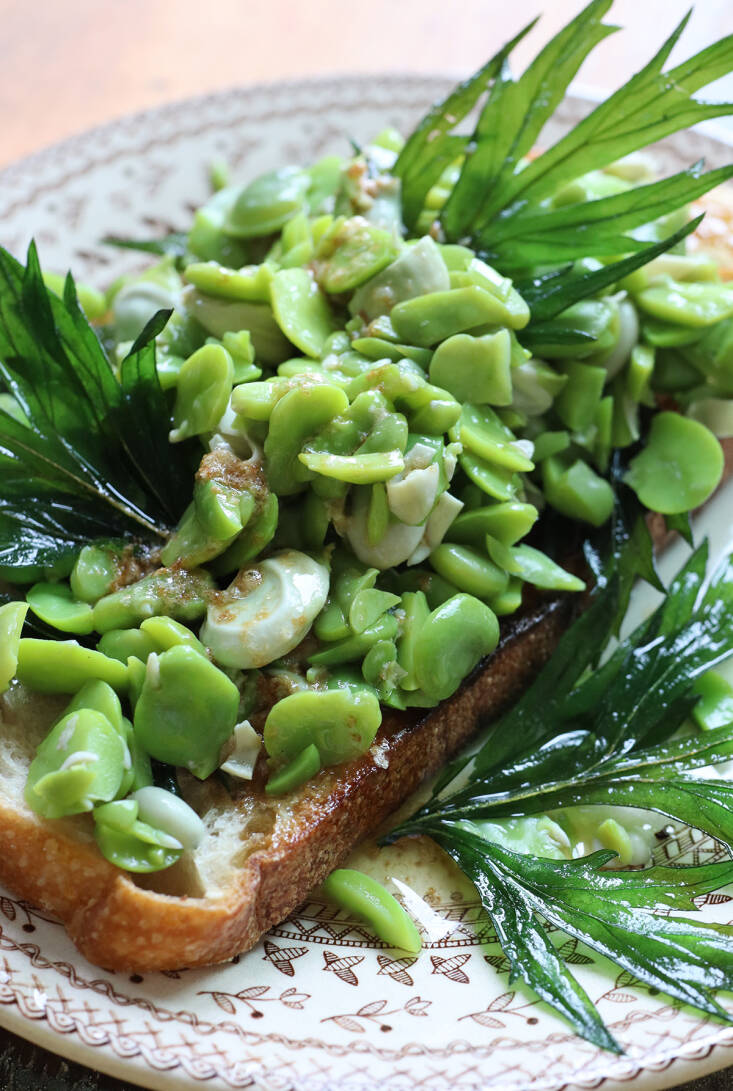For this last week of 2023, we’re republishing the year’s top-performing posts on Gardenista. Enjoy this crowd-pleaser, first published June 26, all over again.
The chances are good that you are surrounded by Artemisia vulgaris. Native to Eurasia, mugwort is highly invasive in North America, displacing swathes of native plants unable to compete with its perennial spread, fueled by an extensive underground rhizome system. But mugwort is also a sage-fragrant and very palatable wormwood. It is rarely used in American kitchens, despite being a culinary herb in parts of Europe, and well known in Korea (where it is called ssuk) and in Japan (yomogi), where a closely-related species (A. princeps) is prevalent and familiar in cooking as well as in traditional medicines. In my forage-inspired kitchen, mugwort is a standard herb.
Join the invasivores. Eat this weed.
Photography by Marie Viljoen.

The first thing I was told about mugwort by a local forager on a walk in 2009 was that it would induce vivid dreams if I put it under my pillow. My dreams seemed unaffected. People do smoke it, and dried mugwort is used in moxibustion. Me, I just eat it.

Mugwort has a long growing season, and multiple useful parts. In very early spring it emerges with soft, silvery leaves at the base of the previous year’s dead sticks. The new leaves can be picked entire and wilted or tempura’d; they have a mild flavor.


By midsummer mugwort has grown to a couple of feet tall—its stems sappily tender and green, and its flavor and scent stronger. The stems can be added entire to braises, curries, and marinades, chopped into stuffings, or put to infuse with red fruits and vodka (scroll down for the recipe). Mugwort leaves are the grounding ingredient in my seasonal vermouths. European vermouth derives its name from Wermut, German for “wormwood.” And Beifuß—the German name for mugwort—is sold as commercial herb in that country, both dried and fresh. In Croatia it is divlji pelin and a traditional ingredient in white-hot digestifs.

The tender early summer leaves can also be crisply fried and used to top a host of summer sandwiches.

By fall it is flowering and now mugwort’s strong, woody stalks can be over four feet tall. It is easy to see why native plants find it impossible to compete. Collecting the flowers and tender seeds is satisfying: simply run a hand backwards down a stalk to strip them off; this is the stage of mugwort I like to dry for use through winter: It flavors a slow-cooked, ritual pozole that I make to carry on a freezing walk to greet each New Year’s Day. And mugwort salt is a staple seasoning, delicious with eggs and scattered across roast potatoes.



Even mugwort’s dry sticks are useful. They are environmentally friendly barbecue skewers, with built-in aroma.
I have begun to see mugwort at New York greenmarkets. In early spring a New Jersey grower, Lani’s Farm, sells its silvery sprigs for more than $20 a pound. I can’t help smiling, because it is growing within reach along a chain-link fence nearby (not that that’s an optimal spot to forage!). But I am genuinely glad that it is being found useful as a marketable herb; it is often the serious price tag itself that brings an unfamiliar ingredient to the attention of shoppers and chefs.

The more mugwort is sold, the more familiar greenmarket patrons will become with it and the more often they will recognize it where it grows in profusion, displacing native plants. Cut it, cut it, cut it. And don’t plant mugwort unless it is contained in a pot, where it will be happy for a while before becoming root-bound. If you do keep it containerized, cut its flower heads to prevent it setting seed.

Caution: To err on the side of excessive caution, steer clear of mugwort in quantity if you are pregnant, wish to be, or are nursing. In medicinal amounts it is used to regulate menstruation. Bear in mind that medicinal applications use a concentrated amount of any herb (and in mugwort’s case the root, too—always a part of a plant to avoid, if you are uncertain). Culinary quantities are far less potent.


Mugwort and Raspberry Liqueur
Adapted from Forage, Harvest, Feast – A Wild-Inspired Cuisine
Makes about 1 quart
Classic Russian Cooking (Indiana University Press, 1992; translated by Joyce Toomre), by Elena Molokhovets was published in the nineteenth century. It is an otherworldly book from whose depths you may never return. Molokhovets includes a recipe for Lingonberry Liqueur that requires half a pound (!) of dry wormwood, which could be a different species. Her instructions are to “pour a pail of vodka” over the herbs. That really would drown your sorrows. Here is my pared-down version, with mugwort. Serve neat over ice with lemon, or with tonic, or mix into cocktails.
- 2 oz fresh mugwort leaves
- 12 oz raspberries
- ½ cup sugar
- 4 cups vodka
Layer the mugwort and raspberries in a clean glass jar. Add the sugar and vodka. Tighten the lid. Tilt back and forth until the sugar has dissolved. Leave to infuse for 6 weeks. Strain through a fine-mesh sieve, and again through double cheesecloth or fine linen. Save the raspberries for an alcoholic dessert, or jam. (Taste one—they’re good!) Bottle in a clean glass bottle—it keeps indefinitely.


Fava Bean and Mugwort on Toast
Serves 2
Cooking summer’s fava beans briefly in water laced with fresh mugwort is a rite of high summer. Dressed with an umani-laden butter, this is an incredibly delicious combination of the farmers market and foraging seasons. I like to pop half the cooked beans out of their grey skins, for their textural and color-contrast, but you don’t have to peel them at all, unless they are tough (I happen to like the taste of fava skins, but not everyone does. The skins are not bad for you, unless you suffer from favism, when you can’t eat any part of the bean).
- 2 tablespoons neutral oil
- 8 mugwort leaves
- Pinch of salt
- 30 fava bean pods (about 2lbs)
- 3 sprigs mugwort (the tender tips of the stems)
- 2 slices sourdough
- 1 garlic clove, peeled
- 2 Tablespoons butter
- 1 Tablespoon soy sauce (or 1 teaspoon Marmite, or 2 teaspoons miso)
For the mugwort: Over medium heat, warm the oil in a large pan. Place the mugwort leaves flat in the pan and cook for 2 minutes, then turn each leaf. Cook the other side until the leaves are crisp, about 2 minutes more (when you lift one up it should stay rigid, not flop). Remove and drain on a paper towel. Season lightly with salt
For the beans on toast: Shell the fava beans. Bring a pot of water to a boil with the 3 sprigs of mugwort. Add the beans, cover, and cook for about 3 minutes, or until tender. Drain. While warm, squeeze about half the beans to pop out their green kernels. Chop them roughly, along with the beans that are still in their skins.
Toast the bread and rub one side of each slice with the peeled garlic clove.
Melt the butter in a small pot over medium heat. Add the soy sauce. Warm through.
Top the toasts with the beans, and pour over the warm butter-soy dressing. Garnish with the crispy mugwort leaves, and dig in!
See also:
- Bayberry: An Herb Native to North America
- Yucca: A Resilient Garden Plant and a Delicious Vegetable
- June Is Serviceberry Season! Here’s How to Use the Foraged Fruit for Sweet Treats
N.B.: This post was first published June 26, 2023.
Frequently asked questions
What is Mugwort?
Mugwort is a herbaceous plant that is native to Europe and Asia. It has been used in traditional medicine and culinary practices for centuries.
What are the differences between Mugwort herb and Mugwort weed?
Mugwort herb refers to the cultivated varieties that are used for medicinal and culinary purposes. Mugwort weed, on the other hand, generally refers to the wild and invasive varieties that can be found in certain regions.
Is Mugwort invasive?
Yes, some varieties of Mugwort can be invasive and spread rapidly. These invasive varieties are often considered as weeds and can be challenging to control in gardens and natural areas.
How can Mugwort be used in cooking?
Mugwort leaves can be used as an ingredient in various dishes. They have a slightly bitter flavor and are often used in teas, soups, and as a seasoning for meats.
What are the medicinal uses of Mugwort?
Mugwort has been traditionally used in herbal medicine to treat various ailments. It is believed to have anti-inflammatory, antifungal, and antibacterial properties. It is also often used to relieve digestive issues and promote relaxation.
How can I control invasive Mugwort in my garden?
Controlling invasive Mugwort can be a challenging task. It is recommended to dig out the plants, including the roots, or use herbicides specifically designed for Mugwort control. Regular monitoring and removing any new growth is essential to prevent re-infestation.
Are there any precautions or side effects to be aware of when using Mugwort?
Mugwort may cause an allergic reaction in some individuals, especially those who are sensitive to plants in the Asteraceae family. Pregnant or breastfeeding women should avoid using Mugwort due to its potential effects on uterine contractions. It is always advisable to consult with a healthcare professional before using Mugwort for medicinal purposes.
Where can I find Mugwort plants or seeds?
Mugwort plants or seeds can often be found at local nurseries or garden centers. They can also be purchased online from reputable seed suppliers or herbal plant retailers.









Have a Question or Comment About This Post?
Join the conversation